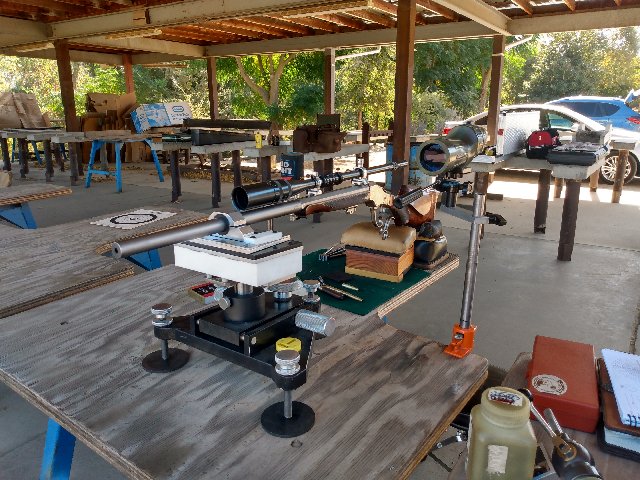You are using an out of date browser. It may not display this or other websites correctly.
You should upgrade or use an alternative browser.
You should upgrade or use an alternative browser.
A situation I have seen several times:
- Thread starter Pete Wass
- Start date
Real interesting question Pete I pay allot of attention to that area to insure a proper fit. You can smoke it, use high spot blue or whatever you prefer to use to verify that there is full contact in that area. Our cast bullet compeitive benchrest shooting is quite abit different than most. It is not unusual to have two or more barrels to switch out. All can be screwed on and off without any tools so they are not screwed on real tight. They do have a retaining screw but the fit of the shoulder to the face of the action is very critical for one to achieve. So it makes me wonder is it the shoulder on the barrel or the face of the action that directly relates to what you are experiencing. This is typical of the rifles that we use and this one is the one that I compete with and the matches are shot at 200 yards.

 image hosting sites
image hosting sites

 image hosting sites
image hosting sites
Last edited:
Rubicon Prec.
New member
Something is obviously moving, unintentionally, or intentionally. I honestly have no idea why someone would move the part between cutting the shoulder and the threads.
GeneT
Active member
I have seen at least 4 and mebby 5 rifles that came from more than one Smith with shoulders on barrels that weren't perpendicular to the tenon. How can this happen? Seems practically impossible yet it happened. Barrels don't stay tight long !
Pete
How are you checking shoulder-to-tenon perpendicularity? I can see this going a dozen different ways...
GsT
mwezell
Mike Ezell
How are you checking shoulder-to-tenon perpendicularity? I can see this going a dozen different ways...
GsT
Here's the most likely problem ^^^
Otherwise, something moved. Or maybe someone else can give me some clarity.
Pete Wass
Well-known member
Visual gap, as I recall
I figured the problem must have been the barrels were either removed from their original setup then cut again or the cut coming back out wasn't enough to clean up the shoulder. Anyway, three different Smiths involved, two from the same one and one each from the other two. Smiths were well known Benchrest Smiths. I had one of the barrels and friends the other three.
Pete
How are you checking shoulder-to-tenon perpendicularity? I can see this going a dozen different ways...
GsT
I figured the problem must have been the barrels were either removed from their original setup then cut again or the cut coming back out wasn't enough to clean up the shoulder. Anyway, three different Smiths involved, two from the same one and one each from the other two. Smiths were well known Benchrest Smiths. I had one of the barrels and friends the other three.
Pete
jackie schmidt
New member
The thread and the tenon shoulder should always be machined on the same setup.
The easiest way to check this is to put a light coat of Prussian blue on the face and lightly seat it agains the action face, (assuming it is correct), and check the contact.
The easiest way to check this is to put a light coat of Prussian blue on the face and lightly seat it agains the action face, (assuming it is correct), and check the contact.
Last edited:
I figured the problem must have been the barrels were either removed from their original setup then cut again or the cut coming back out wasn't enough to clean up the shoulder. Anyway, three different Smiths involved, two from the same one and one each from the other two. Smiths were well known Benchrest Smiths. I had one of the barrels and friends the other three. Pete
Couple of questions, Pete:
- How are the barrels being installed?
- Is there a relief cut ahead of the threads?
Last edited:
geo.ulrich
Member
Couple of questions, Pete:
- Is there a relief cut ahead of the threads?
Bingo there you go......
Pete Wass
Well-known member
I don't recall
but why would a professional do such a thing? I know for sure the one I has wasn't thread bound but don't know about the others.
Pete
Bingo there you go......
but why would a professional do such a thing? I know for sure the one I has wasn't thread bound but don't know about the others.
Pete
geo.ulrich
Member
This will be a little long. Years ago a H.O.F. shooter was complaining his barrel done by another top br gunsmith was not shooting actually a few. I told him bring it by work I wanted to check something. I set it up blued the face and went in and u'cut the threads without removing any bluing while he watched. He took it home and puts it back on. Then calls me headspace had changed .002 shorter. He showed back up that night with around 12 more barrels that "wouldn't shoot . did the same thing blued up and undercut. when he checked them they had moved between .002---,012 difference in headspace and they started to preform. Two things here where the thread ramps up when pulling tool out AND how much offset there is in threading tool. if you think a centered vee insert is going to make it close enough well it won't. A better question to your question to why a Profesional do this is why not it doesn't hurt a thing and you know its shouldering as it should....
Last edited:
Dave Tooley
Active member
Even when the action has a tread relief I still under cut the shoulder enough to eliminate any chance of interference between the barrel shoulder junction and the action face. When I used a manual lathe on the last pass turning the tenon I'd plunge in before pulling the tool across the shoulder. It also doesn't hurt to go right back in and shave a few more tenths off. Then you know it's square.
Pete Wass
Well-known member
I think
some folks think it looks better to not have a relief cut or they may think the barrel may be set back at some point and the relief cut would weaken extending the thread? Realistically, how many barrels get set back? I have done some but haven't worried about the relief groove. Tenny rate, ill fitting barrels can be prevented.
Pete
some folks think it looks better to not have a relief cut or they may think the barrel may be set back at some point and the relief cut would weaken extending the thread? Realistically, how many barrels get set back? I have done some but haven't worried about the relief groove. Tenny rate, ill fitting barrels can be prevented.
Pete
coyotechet
Chet
Question for Jackie
Have a question for Jackie . How do you cut the shoulder when you set a barrel back with the threads already cut?

Thanks Chet
The thread and the tenon shoulder should always be machined on the same setup.
Have a question for Jackie . How do you cut the shoulder when you set a barrel back with the threads already cut?
Thanks Chet
I turn the tenon .010 short, I grind a right facing tool, with a point that is ~80 degrees (acute), set the compound rest at 90 degrees and plunge into the face 0.010" out from the tenon 0.010" and slowly draw out watching the cut carefully to make sure it's a proper facing. I do the same thing to a muzzle thread, because i want the brake to barrel fit to be invisible.
Attachments
Butch Lambert
Active member
I turn the tenon .010 short, I grind a right facing tool, with a point that is ~80 degrees (acute), set the compound rest at 90 degrees and plunge into the face 0.010" out from the tenon 0.010" and slowly draw out watching the cut carefully to make sure it's a proper facing. I do the same thing to a muzzle thread, because i want the brake to barrel fit to be invisible.
Ben, when you are indicated and before your cut, is the old shoulder perpendicular to your bore?
Something quite like this can happen quite easily when indexing or "timing" barrels IME. Not that the threads or shoulder are out of alignment, but that the undercut at the shoulder can be left at an interference..... this need be checked carefully. For instance I did one today where my initial setup, tenon offset/length resulted in the barrel tightening up just past where I wanted it. This required that I rotate the barrel nearly another full turn, advancing it or "lengthening the tenon" about .045 which moves the abutment shoulder the same 45thou down the barrel. I had to remember to widen the chickenout groove 35 thou toward the muzzle.
Had I not paid attention the barrel would have tightened up against the threads instead of bottoming out and crushing against the shoulder.
I'm with Jackie re the use of Dykem. If the barrel doesn't wipe the Dykem immediately, as in FIRST THING as soon as it feels somewhat tight, the relief must be extended toward the muzzle.
Had I not paid attention the barrel would have tightened up against the threads instead of bottoming out and crushing against the shoulder.
I'm with Jackie re the use of Dykem. If the barrel doesn't wipe the Dykem immediately, as in FIRST THING as soon as it feels somewhat tight, the relief must be extended toward the muzzle.
JerrySharrett
Senile Member
Sometimes the shoulder is cut with the SIDE of the grooving tool.
.
.


